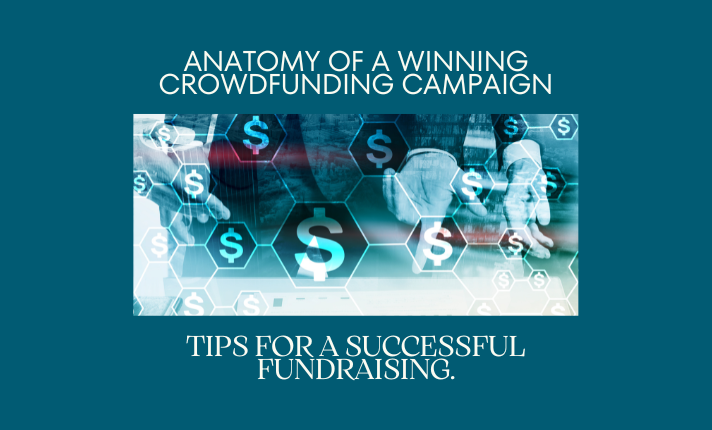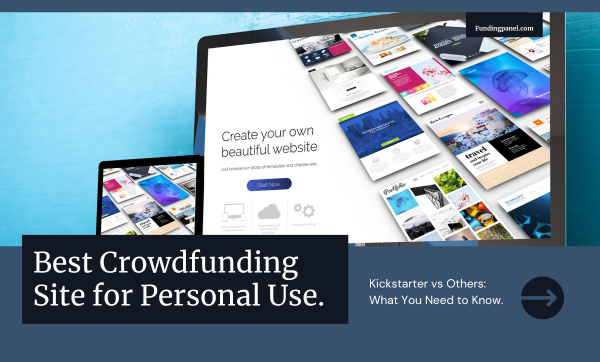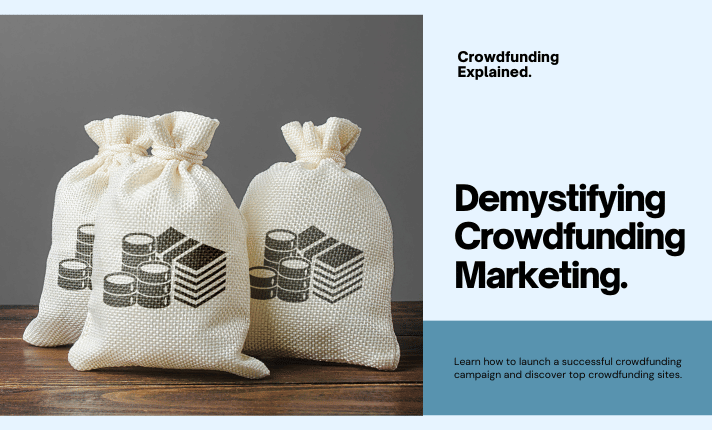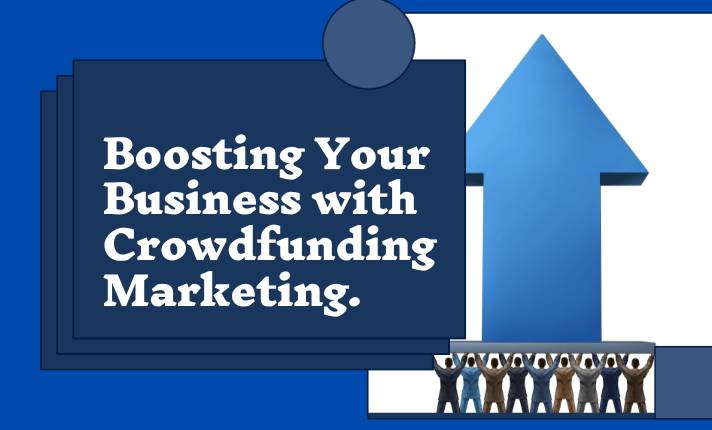Intro
Welcome to the world of crowdsourcing, where company owners and entrepreneurs can use the collective power of the public to realise their dreams. In recent years, startups seeking their first round of funding have turned to crowdfunding sites like Indiegogo and Kickstarter. But how do you differentiate your campaign from the countless others vying for viewers’ attention? Crowdfunding marketing can help with that. An effective marketing plan for Kickstarter can mean the difference between a successful campaign and a failure to reach its objectives. In this blog post, we’ll dissect the anatomy of a successful crowdfunding campaign and examine the essential components that set it apart from the competition. Prepare to discover the fundamental principles and tactics for developing an effective crowdsourcing campaign that draws viewers in and wins over devoted supporters.
Understanding the Concept of Crowdfunding
A novel way of obtaining capital for an endeavour or project is crowdfunding, which involves collecting modest sums of money from many individuals, usually online. The power of crowdfunding can be imagined as an online assembly of people worldwide, each contributing to the realisation of your idea. It operates under a group effort, in which several people pool their resources to fund a business venture, project, or idea jointly. Crowdfunding comes in various forms: reward-based, debt-based, equity-based, and donation-based. You may decide on one over the others based on your project. Rewards-based crowdfunding is popular among startups and creative projects; backers receive a product or service in exchange for their contribution. This makes websites like Indiegogo and Kickstarter the best options. Crowdfunding’s beauty is its ability to link innovators with investors eager to support new and exciting ideas. Building an enthusiastic community excited to realise your idea is more important than money.
Choosing the Right Crowdfunding Platform
Choosing the best platform for your crowdfunding campaign is essential. Numerous platforms are available, each with unique features, advantages, and target audiences. Two of the most well-known websites that support a wide range of innovative projects and startups are Kickstarter and Indiegogo. Kickstarter is a prominent platform for tech and design enthusiasts, so it might be your best option if your venture involves these fields. Conversely, Indiegogo is more adaptable and allows for more projects, including charitable endeavours. While equity-based platforms like SeedInvest and CircleUp are appropriate for companies wishing to exchange capital for equity, other platforms, such as GoFundMe, are dedicated to supporting charitable causes. Your decision should fit your project’s purpose, audience, and budget. Take your time and investigate each platform’s costs, success rates, and promotional offers before making a choice. Your campaign’s visibility and likelihood of success can be significantly increased with the appropriate platform.
Crafting a Compelling Campaign Story
Crafting a compelling story for your campaign is essential to winning over potential backers’ interest and affection. A gripping narrative elicits empathy and excitement in your audience by connecting with them on an emotional level beyond simply describing the purpose of your project. Explaining your enthusiasm for your idea should come first. Please describe the issue your offering is resolving and how customers will profit from it. To make your story understandable to everyone, use simple, everyday language and stay away from jargon. In your storytelling, images are also vital. Better than words alone, high-quality pictures and videos can help you convey your vision.
Furthermore, don’t be afraid to share your journey—the difficulties you’ve encountered, the victories you’ve had, and the path that brought you to this point. Credibility and trust are significantly increased by authenticity. Recall that individuals invest in people, not just concepts. Demonstrating your commitment, perseverance, and enthusiasm will encourage possible supporters to accompany you on your path to achievement.
Setting a Realistic Funding Goal and Offering Rewards
One of the most essential parts of your crowdfunding campaign is figuring out a reasonable funding target. Determine the absolute minimum amount required to make your project a reality first. Add production, shipping, platform fees, taxes, and other unanticipated costs. A goal that is too high could turn away potential backers, and a goal that is too low could leave you without enough money to pay out rewards. Rewards are an essential component of your crowdfunding story and not just a means of rewarding backers. Make sure they appeal to your target audience and align with your project’s value. Provide a range of incentives at varying pledge levels to accommodate backers with varying financial capacities. This can be anything from a sincere note of gratitude to unique opportunities or limited-edition goods. Recall that rewards must be realistic for you to deliver and worthwhile for your backers to invest. Your credibility and backers’ trust may suffer if you make excessive promises and fall short of them. Thus, carefully consider the cost of production and delivery when designing your rewards. Ultimately, your objectives and prizes demonstrate the value you’re providing and foster enthusiasm for your undertaking.
Building a Solid Pre-Launch Strategy
A solid pre-launch strategy can significantly increase the likelihood of your crowdfunding campaign’s success. Create excitement and anticipation for your project before going live. To begin with, Determine your target market, then focus your marketing efforts on meeting their needs and interests. Use blogs, newsletters, and social media to create a community of supportive individuals. To give people a better understanding of your project and its possible effects, host webinars or live Q&A sessions. Contact bloggers or influencers in your field to increase your reach and think about working together. Create a visually appealing landing page that includes an email sign-up form to collect leads and inform prospective backers about the status of your campaign. Publish pre-launch advertisements to increase traffic to your landing page and determine potential backers’ level of interest. Not only will this aid in raising awareness, but it will also yield insightful comments. When you launch, set up a solid email marketing campaign to convert these leads into devoted supporters. You’ll be up and running when your campaign launches with a well-thought-out pre-launch strategy.
Managing Your Campaign and Maintaining Engagement
Your work continues when your campaign goes live. Sustaining a dynamic campaign necessitates regular interaction with supporters and potential backers. Provide regular updates on the state of your project, the milestones you’ve reached, and any difficulties you’ve encountered. Maintaining transparency keeps supporters interested in your journey and builds trust. Promote communication by promptly answering questions, comments, and messages. Recall that crowdfunding is a two-way conversation, and the input from your backers can yield incredibly insightful information. Utilising social media is essential as well. Share interesting content regularly that speaks to your audience, and feel free to highlight the human aspect of your work. AMAs (Ask Me Anything) and live video hosting are great ways to build community. Make sure you keep this engagement going after the campaign. Maintaining backers’ trust and support for future projects depends on you keeping your word and updating them on the status of rewards delivery. Recall that the relationships you build along the way are just as crucial to the success of your campaign as the money you raise.
Understanding the Legal Aspects of Crowdfunding
Although navigating the legal environment around crowdfunding can be difficult, it’s a crucial step in running your campaign. Different crowdfunding models have other legal implications. Like Kickstarter and Indiegogo, reward-based crowdfunding usually entails exchanging products or services for contributions, which may give rise to liability and sales tax obligations. Equity-based crowdfunding, conversely, entails the sale of securities subject to stricter legal requirements and regulated by the Securities and Exchange Commission. It’s critical to comprehend the terms and conditions of the platform you’ve selected to prevent breaking any guidelines that can result in fines or possibly the suspension of your campaign. Another important consideration is protecting your intellectual property, particularly for creative projects. It would help if you considered using patents, trademarks, or copyrights to stop idea theft. Finally, remember that any funds raised via crowdfunding are taxable, so account for that when creating your budget. Consider speaking with a legal expert to ensure you’re on firm legal ground and avoid costly and damaging legal blunders. Even though it might seem complicated, knowing the law can protect your business and make your crowdfunding experience easier and more fruitful.











